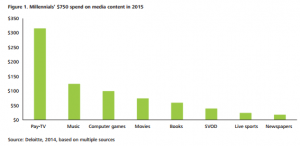According to a study by Deloitte, North American millennials will spend over $62 billion on media content in 2015. This is greater than the total spend on internet advertising in the US and Canada , and as such represents a significant contribution to the media sector from the generation of 18-34 year-olds often accused of defaulting to unpaid sources of content. There are 83 million millennials in the US and Canada, and $62 billion of spending on media content equates to $750 each.
The reality is that millennials are spending less on traditional media than they did in the past, and less than older generations, but they are still spending.
 Cumulative media spend of $62 billion for this age group in the US and Canada is a significant amount, but this is less than five per cent of their total expected spending of $1.45 trillion. It may seem that 18-34 year-olds are allocating less of their spending power to content than people of similar ages did in the past. However spending less on content is surprisingly expensive: consuming news, video and music for free requires expensive hardware and high-speed wired and wireless internet access.
Cumulative media spend of $62 billion for this age group in the US and Canada is a significant amount, but this is less than five per cent of their total expected spending of $1.45 trillion. It may seem that 18-34 year-olds are allocating less of their spending power to content than people of similar ages did in the past. However spending less on content is surprisingly expensive: consuming news, video and music for free requires expensive hardware and high-speed wired and wireless internet access.
The average millennial owns one or more new smartphones and has a big monthly data plan. Streaming video over a wireline connection requires a fast service (at least 5 Mbit/s to stream high definition video and up to 25 Mbit/s for ultra-high quality 4K video) with either a big cap or unlimited consumption. Millennials who replace their PC and tablet every four years and their games console every five would spend about $3,000 per year on technology hardware and connectivity.
Millennials will likely continue to spend heavily on tech hardware and telecom services, but it may come at the expense of media and content spending. They will still spend on content, but may be choosier and more-price sensitive than young audiences in the past.
Oddly enough, the fact that millennials who won’t spend on traditional media are willing to spend on other kinds of content is not bad news for the traditional media industry. If they weren’t willing to spend at all, then there would be no hope. But the experience of the book, computer gaming, OTT providers, cinema and music industries establishes that millennials will open their wallets for certain types of media.
In conclusion, the sky may well be falling on traditional journalism and the people behind it, but in 2015 members of the internet generation will fork over billions in hard-earned cash for all sorts of media – including the old-school paper kind.

